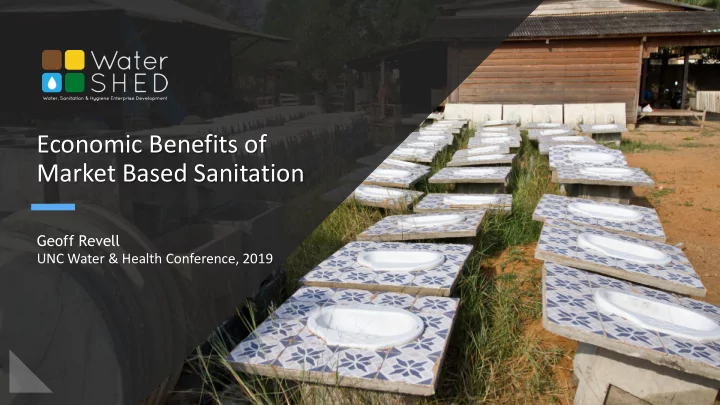

1 Economic Benefits of Market Based Sanitation Geoff Revell UNC Water & Health Conference, 2019
2 Existing Methods for Cost-Benefit Analysis Value of benefits : • Direct economic benefits of avoiding diarrhoeal disease (e.g. healthcare costs) • Indirect economic benefits related to health improvement (e.g. productivity) • Time savings (e.g. time traveling to or waiting for water or the toilet).
3 Existing Methods for Cost-Benefit Analysis Table 1. From: Hutton.G. (Mar 2012) Economic Assessment of Sanitation Interventions in Cambodia, WSP Technical Paper.
4 Emergence of Market Based Sanitation Opportunity to better understand the market activity needed to deliver products and services.
5 Market based sanitation (MBS) : “The development of a sanitation market in which the user makes a full or partial monetary contribution … toward the purchase, construction, upgrade, and/or maintenance of a toilet from the private sector. ” Scaling Market Based Sanitation, FSG/USAID, June 2018.
6 Upstream Effects Downstream Benefits
7 Estimating both A novel model to capture the downstream economic benefits to households that purchase products and services as well as the upstream economic benefits to the market actors that produce them
Conceptual framework The model defines a market of interest (MOI) and compares the costs and benefits between a ‘program scenario’ and a theoretical scenario in which the program does not exist (DNE scenario). The MOI is defined by three dimensions: • The product/service • Target market • Time period
Assumed Program Activities 1. Demand fulfillment : support market actors to provide better products or services at a lower price (e.g. product design support, professional skills training, etc.) 2. Demand generation/activation: activities to increase consumers’ perceived value of product or service, (marketing campaigns, use of sales agents)
Key terms Total market value (TMV) is the product of the quantity of latrines sold and their market price (including retail mark-up, sales commission, shipping, installation). Total sanitation benefit (TSB) is the total downstream benefit to households. TMV is equal to the total cost to the economy to produce latrines, while the TSB is the total benefit generated by latrines.
Limitations, Assumptions Not a whole-economy model TMV is not economic impact, it is spending that is endogenous to the economy, which could be substituted; it represents reallocation of resources. Assumes that households in both Program Scenario and DNE Scenario do not spend their income on other items that improve their productive capacity. Assumes that latrine producers and their employees live in same areas as customers and spend on the same bundle of goods .
12 Application in Practice WaterSHED’s Hands-Off program (2011-2017 )
Hands-Off Program (2011-2017) The program aimed to build the local market in rural areas for high-quality toilets by: 1. Supporting small businesses to produce low cost, improved latrines 2. Increasing demand for toilets through innovating commercial marketing 3. Engaging local government, MFIs, and other actors to facilitating ongoing marketing development and growth
14 Calculations - DNE DNE Scenario: Total Market Value DNE Scenario: Total Latrine Sales
15 Calculations - DNE DNE Scenario: Sanitation Benefit Total Sanitation Benefit / Total Market Value = market efficiency ratio $121.3 million / $73.3 million = 1.65
16 Calculations - Program Program Scenario: Total Market Value Program Scenario: Total Latrine Sales SPs Non SPs
17 Calculations - Program Program Scenario: Sanitation Benefit Total Sanitation Benefit / Total Market Value = market efficiency ratio $248.3 million / $82.1 million = 3.02
18 Results In the program scenario: • latrine sales more than doubled in underserved, rural areas • costs to consumers were 53% lower • TMV increased by $8.6 million • there was an additional $1.9 million in profits to latrine producers and $2.9 million in wages to the labor they hire • TSB increased by $127 million
19 Results (cont) DNE scenario: every dollar invested contributes $1.65 to the economy due to improved health outcomes and time savings Program scenario: every dollar invested contributes $3.03 to the economy DNE scenario: $48 million value added to the Cambodian economy over 7 years Program scenario: $166.4 million over the same period.
20 Discussion By comparing these two scenarios the model elucidates how the program has transformed the MOI and how this impacts the wider economy.
21 Discussion The Asian Development Bank Tonle Sap Rural WaterSHED’s Hands-Off program Water Supply and Sanitation Sector Project (TSRWSSSP) • • Program expenditure: $4.68 million Program expenditure was $2.65 million • • 45,056 latrines installed over 4.5 years 246,212 latrines installed over 7 years • • Cost $103.87 per latrine Cost $10.77 per latrine
22 Discussion
23 Thank You
Recommend
More recommend